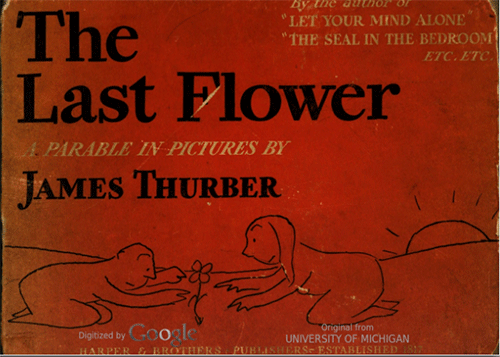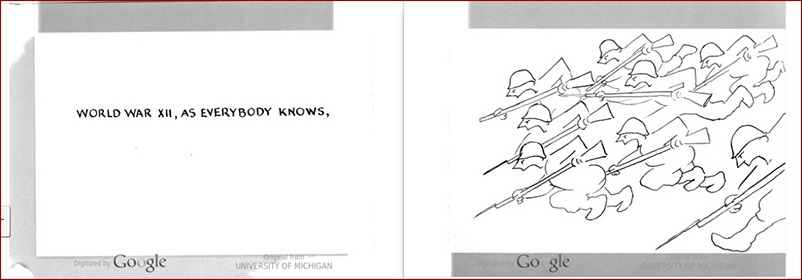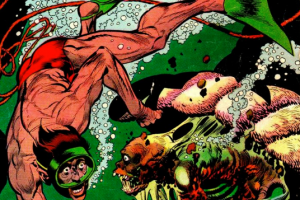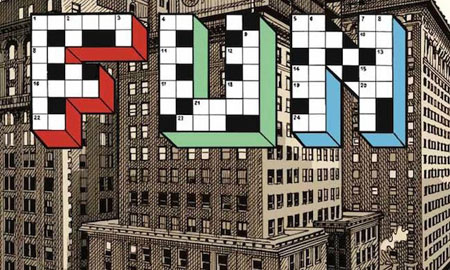Tag: Graphic Novels
The Last Flower: A Parable in Pictures

Originally published in November 1939, two months after World War II officially began, James Thurber’s The Last Flower: A Parable in Pictures is a graphic novel ahead of its day. Inspired in particular by the Spanish Civil War and the Nazi and Soviet invasion of Poland, it chronicles the eternal cycles of war, peace, love, and the resilience of one little flower and remains as relevant today as it was then. The text has been translated into dozens of languages worldwide, among them a French translation by Albert Camus and published by Gallimard in 1952. A native of Columbus, Ohio, Thurber was not only a cartoonist but also an author, humorist, journalist, playwright, and celebrated wit who joined the staff of the New Yorker in 1927 where he remained for most of his career.
Reissued by the University of Iowa Press in 2007, the first edition and later edition are temporarily available online to the UC community through the HathiTrust Emergency Temporary Access service until the UC libraries fully reopen this fall. You can learn more about The Last Flower at the Columbus Public Library’s Art Unbound II exhibition installed in its Carnegie Gallery.

Primary Sources: Underground and Independent Comics, Comix, and Graphic Novels
 The Library has recently acquired an online archive of Underground and Independent Comics, Comix, and Graphic Novels, described on the publisher’s website as the “first-ever scholarly online collection for researchers and students of adult comic books and graphic novels. This multi-part resource covers the full spectrum of this visual art form, from pre-comics code era works to modern sequential releases from artists the world over.
The Library has recently acquired an online archive of Underground and Independent Comics, Comix, and Graphic Novels, described on the publisher’s website as the “first-ever scholarly online collection for researchers and students of adult comic books and graphic novels. This multi-part resource covers the full spectrum of this visual art form, from pre-comics code era works to modern sequential releases from artists the world over.
“From the shocking and explicit work of young artists exploring newfound freedoms to intricate and beautiful designs of aesthetic craftsmanship, the comic book has shown itself to be a medium capable of both the offensive and the sublime. Now users can experience the full range of this offbeat art form by exploring 200,000 pages of original material alongside interviews, commentary, criticism, and other supporting materials.”
Graphic Novels from Belgium, France, Italy, Portugal and Spain

Here’s a fairly complete list of most of the graphic novels acquired by the Library in the romance languages from southern Europe over the past two years. Some are critical or reference works, and a few English translations have been included as well.
-
Alexandre Jacob : journal d’un anarchiste cambrioleur / Vincent Henry, Gaël Henry. Paris : Sarbacane, 2016.
-
Alfa, Beta, Bronson / Ramón Rodríguez, José Ramón Grela. Barcelona : Ediciones La Cúpula, 2016.
-
Algériennes : 1954-1962 / Swann Meralli & Deloupy. Paris : Marabout, 2018.
-
America / Nine Antico. Grenoble : Glénat, 2017.
-
Asylum / Javier de Isusi. Bilbao : Astiberri : CEAR-Euskadi, 2017.
-
Avery’s blues / guión, Angux ; dibujo, Núria Tamarit. Madrid – España : Dibbuks, 2016.
-
Blackbird days / Manuele Fior ; translated by Jamie Richards. Seattle, WA : Fantagraphics Books, 2018.
- Cette machine tue les fascistes / Jean-Pierre Pécau, Senad Mavric. Paris : Futuropolis, 2016.
- Chateaubriand / Nena, Witko. Nantes : Vide Cocagne, 2016.
- Che cos’è il graphic novel / Stefano Calabrese, Elena Zagaglia. Roma : Carocci editore, maggio 2017.
- Como viaja el agua / Juan Díaz Canales. Bilbao : Astiberri, 2016.
- Corta e cola : discos e histórias do punk em Portugal (1978-1998) / Afonso Cortez. Lisbon : Chili com Carne : Thisco, 2017.
-
Corto Maltese e la poetica dello straniero : l’atelier carismatico di Hugo Pratt / Stefano Cristante. Milano : Mimesis, 2016.
-
Cómic, arquitectura narrativa / Enrique Bordes. Madrid : Cátedra, 2017.
-
Demasiado guapo / Sebas Martín. Barcelona : La Cúpula, 2016.
-
Dr. Uriel / Sento. Bilbao : Astiberri, 2017.
-
Elle(s) / scénario et dessin Bastien Vivès. Bruxelles : Casterman, 2017.
-
El solar / Alfonso López. Barcelona : La Cúpula, 2016.
-
El viaxe a la lluz / Ruma Barbero. Xixón, Asturies : Suburbia Ediciones : Gobiernu del Principau d’Asturies, mayu 2016.
-
Espacios en blanco / Miguel Francisco. Bilbao : Astiberri, 2017.
-
The expanding art of comics : ten modern masterpieces / Thierry Groensteen ; translated by Ann Miller. Jackson : University Press of Mississippi, 2017.
- Fissa, papa… : de la cité au bled, du bled à la cité / Amazing Améziane. Vanves : Marabout, 2017.
- Frapper le sol : Tatsumi Hijikata sur la voie du butô / Céline Wagner. Arles : Actes sud, 2016.
- Freezer / Veronica “Veci” Carratello. Milano : Bao publishing, 2016.
- Fuga de la muerte / Fidel Martínez. Castalla (Alicante) : Edicions de Ponent, 2016.
- Fun / written and illustrated by Paolo Bacilieri ; translated from Italian by Jamie Richards. London : SelfMadeHero, 2017.
List continues on the library research guide for European Comics & Graphic Novels—>
